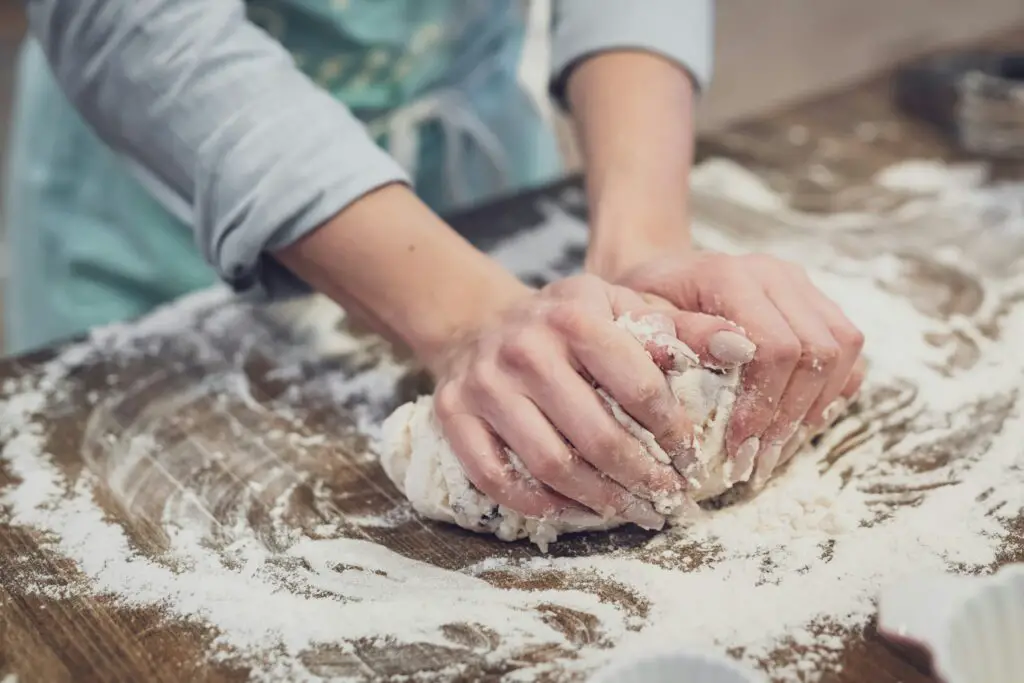Baking bread feels like magic, until your dough refuses to rise or the crust cracks like a desert floor.
Frustrating? Absolutely. But you’re not alone. Even pro bakers hit a snag or two.
The bright side? Most bread failures have quick fixes.
Let’s break down five common problems and show you exactly how to turn those baking flops into golden, fluffy wins.
Problem #1: My Bread Didn’t Rise
What’s Going Wrong
Few things deflate your baking confidence like a loaf that stays flat. If your bread didn’t puff up like it was supposed to, your yeast likely didn’t do its job—or didn’t get the chance to.
Weak or expired yeast is one of the most common culprits. Yeast is alive, and if it’s too old or stored improperly, it might be completely inactive. Think of it like trying to wake up a bear in the middle of winter—it’s just not going to move.
Cool dough is another sneaky issue. Yeast needs warmth to activate and grow. If your ingredients or room are too cold, the yeast hits the snooze button.
Not enough rising time can also lead to disappointment. Dough needs time to develop gas and structure. If you’re rushing the process (we’ve all been there), it won’t rise fully.
Too much salt or sugar can stunt yeast activity. Salt toughens the dough and slows fermentation, while sugar draws out moisture. Used in moderation, they’re helpful. Too much, and they bully the yeast into submission.
Solutions
Start by proofing your yeast in warm water—around 100°F (38°C). Add a pinch of sugar and wait five minutes. If it bubbles and foams, you’re good to go.
If not, toss it and start fresh. Dead yeast won’t magically resurrect in your dough.
Always check the expiration date on the yeast packet. If it’s close to or past the date, don’t gamble. Buy a new batch and store it in the fridge or freezer for longer shelf life.
Keep your dough warm while it rises. Aim for a cozy, draft-free spot—on top of the fridge, inside an off oven with the light on, or near a sunny window. Cold kitchens lead to cold dough, and cold dough leads to sad bread.
Lastly, watch your salt and sugar levels. Stick to the recipe and don’t go overboard. If you’re experimenting, adjust carefully. When in doubt, less is more—at least until your yeast has done its thing.
Problem #2: My Bread Is Dense or Heavy
What’s Going Wrong
If your bread feels more like a brick than a fluffy loaf, you’re not alone. A dense, heavy texture usually means something went sideways during the mixing, kneading, or proofing process.
One major reason? Under-kneaded dough. Kneading develops gluten—the stretchy network that traps air and gives your bread that light, chewy texture.
If you skimp on kneading, your dough won’t have the strength to rise properly. It’s like building a balloon with holes—nothing stays in.
Another sneaky culprit is too much flour. It’s easy to think more flour equals better structure, but it often leads to a dry, tight dough that can’t expand.
Especially if you’re scooping from the bag, you may be packing in way more flour than needed.
Cold ingredients can also weigh things down. Yeast loves a warm environment, so using milk, eggs, or water straight from the fridge slows everything to a crawl.
It’s like trying to start a campfire with damp wood—possible, but frustrating.
Finally, overproofing or underproofing throws everything off. If you let it rise too long, the dough collapses. Too short, and it hasn’t built enough air to lift itself.
Proofing is the Goldilocks zone of bread baking—it has to be just right.
Solutions
First, knead thoroughly. Whether by hand or with a mixer, aim for dough that’s smooth and springy.
A good test? Stretch a small piece between your fingers—if it forms a thin “windowpane” without tearing, you’re golden.
Next, measure flour carefully. If you’re using cups, spoon the flour in lightly and level it off. Better yet, use a digital scale. It takes the guesswork out and makes your results way more consistent.
Let your ingredients come to room temperature before mixing. That includes liquids, eggs, and even butter. Cold dough equals sluggish yeast, and sluggish yeast equals sad bread.
And don’t eyeball proofing—test it. Poke the dough gently with your fingertip. If it springs back slowly and leaves a slight dent, it’s ready.
If it bounces back fast, it needs more time. If it collapses, it’s gone too far.
Problem #3: My Bread Is Too Dry or Crumbly
What’s Going Wrong
There’s nothing worse than slicing into a fresh loaf and watching it crumble like dry cake.
If your bread is falling apart or feels like you’re chewing cardboard, chances are it’s dried out during baking—or never had enough moisture to begin with.
One big offender? Overbaking. Even a few extra minutes in the oven can zap all the moisture from your loaf.
Bread continues to cook after it comes out, so if you’re waiting until it’s bone-dry inside, you’re already too late.
Another common issue is too much flour. When the dough is stiff and dry from the start, it can’t trap steam properly during baking, which means less softness in the finished loaf.
Over-measuring flour (especially if scooped straight from the bag) is an easy mistake with big consequences.
And sometimes, the recipe itself just needs more fat or liquid.
Some lean doughs (like French bread or baguettes) are meant to be crusty, but if you’re looking for a softer or moister result, you need to enrich the dough with a little extra love—think oil, butter, or milk.
Solutions
First, use an oven thermometer. Many home ovens run hotter than they claim, and if your oven’s too warm, your bread is overbaking before the timer even dings.
An inexpensive thermometer can save you a lot of dry loaves.
If the top is browning too fast, don’t be afraid to tent the loaf with foil halfway through baking. This protects the crust from burning while letting the inside finish cooking gently.
If you like softer, more tender bread, try enriching your dough. Add a tablespoon of oil, melted butter, or milk to the mix.
It not only adds moisture but also makes the crumb softer and gives the crust a slight golden hue.
And of course, always measure flour carefully. Spoon it into your measuring cup or, better yet, use a kitchen scale. Small tweaks in flour quantity can make or break your bread’s texture.
Problem #4: My Bread Cracked Weirdly or Burst Open
What’s Going Wrong
You pull your bread out of the oven, and instead of a smooth, golden top, it looks like it exploded.
Weird side cracks, torn bottoms, or giant blowouts across the top? Yep, we’ve all been there.
This usually comes down to one of three things: no scoring, overproofed dough, or a cold oven.
First, if you skipped scoring the dough (those intentional slashes bakers make before baking), the bread will find its own way to release steam. And it won’t be graceful.
The crust hardens in the oven, and without a path to expand, the dough bursts wherever it can. Think of it like popcorn—it needs a place to pop.
Overproofed dough is another common cause. If the dough sits too long after rising, it becomes unstable and weak.
When it hits the heat, it deflates or bursts unpredictably. It’s like stretching a balloon too far—one more puff and boom.
Lastly, if your oven wasn’t hot enough at the start, your bread didn’t get that initial burst of heat (called “oven spring”) that helps set the crust.
Instead, the dough tries to expand slowly, and the crust cracks in all the wrong places.
Solutions
The first fix? Score your dough. Right before baking, take a sharp knife, bread lame, or even a razor blade and make shallow slashes on the top of your dough.
This gives the steam an escape route and allows your bread to expand in a controlled way. Bonus: it also looks beautiful.
Second, bake your dough as soon as it finishes rising. Don’t let it sit around on the counter. Once it’s proofed, get it into the oven.
If you’re unsure whether it’s ready, do the poke test—if the dough springs back slowly and leaves a slight dent, it’s go time.
Third, preheat your oven fully. Let it reach the correct temperature before putting your dough in. Most recipes call for a hot oven (typically 425–475°F or 220–245°C).
And for even better results, bake with steam in the first 10–15 minutes. You can do this by placing a tray of hot water in the oven or spritzing the inside with water just before baking.
Steam keeps the crust flexible while the loaf rises, which helps prevent those wild blowouts.
Problem #5: My Bread Has a Gummy or Underbaked Center
What’s Going Wrong
You slice into your freshly baked loaf… and the middle is wet, sticky, and doughy. It looks done on the outside, but the inside? Total flop.
This is a classic case of underbaking, and it usually comes down to timing, temperature, or loaf size.
One common mistake is removing the bread too early. It might look done—the crust is golden, your kitchen smells amazing, and you just can’t wait any longer.
But looks can be deceiving. Bread needs time to bake all the way through, especially in the center. Pull it out too soon, and the middle stays gummy.
Another reason could be that your oven was too hot. When the oven’s cranked up too high, the outside cooks and browns way too fast, while the inside barely catches up.
It’s like cooking a big roast on high heat—the outside will burn before the inside even warms up.
And if you’re baking a larger or thicker loaf, you simply may not be giving it enough time in the oven. Bigger loaves take longer to cook through.
Cutting corners here leads to a crusty shell and a raw middle.
Solutions
First, tap the bottom of the loaf. This old-school trick works like a charm. Carefully remove your bread from the pan and give the bottom a thump with your knuckles.
If it sounds hollow, like knocking on a wooden table, it’s done. If it sounds dull or soft, it needs more time.
For extra precision, use a food thermometer. Stick it into the center of the loaf. When the internal temperature reads 190–200°F (88–93°C), you’re in the clear.
It’s a foolproof way to avoid cutting into raw dough.
If you consistently run into gummy centers, try lowering your oven temperature by 10–15 degrees and baking a little longer.
This gives the heat time to work its way through the loaf without over-browning the crust.
You can also loosely cover the top with foil partway through baking to protect it while the center finishes up.
Bonus Tips
Keep a Bread Baking Journal
If you really want to level up your bread game, start keeping a bread baking journal. Sounds nerdy? Maybe. But it’s a game-changer.
Jot down the basics: date, recipe used, flour type, rise times, room temp, and how it turned out.
Did the dough rise faster than expected? Was the crust too hard? Did you accidentally use cold water? Write it all down.
Over time, you’ll start spotting patterns—what works in your kitchen, with your oven, in your climate. And the next time something goes wrong (or goes right), you’ll have a cheat sheet.
Baking bread is part science, part art—and keeping notes gives you a little more control over both.
Try Beginner-Friendly Recipes
If you’re just starting out—or rebuilding confidence after a baking fail—stick to beginner-friendly recipes.
You don’t need to jump into artisan sourdough with wild hydration levels and bannetons and scoring patterns just yet.
Start with no-knead bread, which basically mixes itself while you sleep. Or a classic sandwich loaf that’s simple, predictable, and totally satisfying.
These recipes teach you the fundamentals without overwhelming you. Plus, they’re super forgiving. Miss a step? You’ll probably still get a decent loaf.
Once you’ve nailed the basics, you can experiment with add-ins, different flours, or fancier shaping techniques.
Join Online Bread Baking Communities
Got questions? Weird loaf shape? Strange air bubbles? Someone out there has been through it—and they’ve probably posted about it.
Join online bread baking communities like r/Breadit on Reddit, Facebook bread groups, or even follow small bakers on Instagram.
These spaces are goldmines for troubleshooting, tips, and encouragement. You’ll find everything from pro-level advice to hilarious bread fails.
And don’t be shy—share your wins and your flops. You’ll learn faster, connect with other bakers, and realize that even the ugliest loaves have a story (and probably still taste amazing).
Final Words
Bread baking isn’t always smooth sailing—but most problems are easier to fix than you think. A little patience, a few tweaks, and you’re back on track.
Keep experimenting, keep learning, and don’t be afraid to mess up. Even the flops teach you something.
Which problem have you faced the most? Let us know in the comments—or tag us in your next successful loaf!
FAQs
Can I save dough that didn’t rise?
Sometimes, yes—don’t toss it just yet. First, check if the yeast was old or the environment too cold.
Try moving the dough to a warmer spot and give it more time (sometimes up to an hour or two).
Still no action? Mix in a new batch of yeast dissolved in warm water and knead it back in. It won’t be perfect, but it might still bake into something usable—like flatbread or pizza dough.
How do I fix overly salty dough?
Unfortunately, there’s no perfect fix once salt is mixed in. But you can try doubling the batch—make another dough with no salt, then combine the two.
It’ll dilute the saltiness and save your work. If that’s not an option, bake it anyway and use the bread for things where saltiness works—like croutons or savory toasts.
Why does my bread taste yeasty?
A strong yeasty flavor usually means you used too much yeast or didn’t let it ferment long enough. Fast rises can leave that sharp, fermented taste.
Next time, try using less yeast and give the dough a longer, slower rise. Overnight in the fridge works wonders and gives your bread better flavor and texture.
What’s the best flour for beginner bakers?
All-purpose flour is a great place to start. It’s versatile, widely available, and works for most basic bread recipes.
If you want chewier, bakery-style results, bread flour has higher protein and builds more gluten—great for sandwich loaves and rolls.
Avoid jumping into whole wheat or specialty flours too early—they behave differently and are less forgiving. Start simple, master the basics, then branch out.



